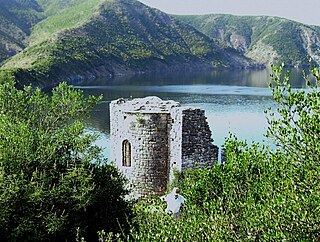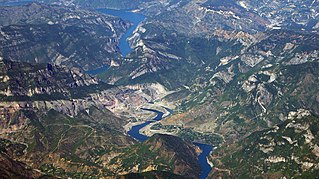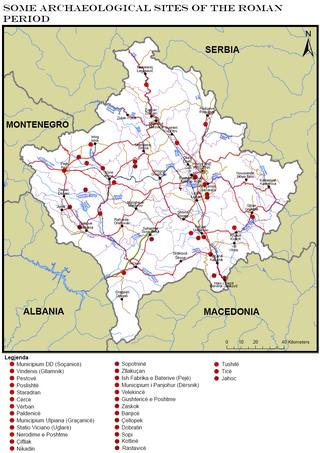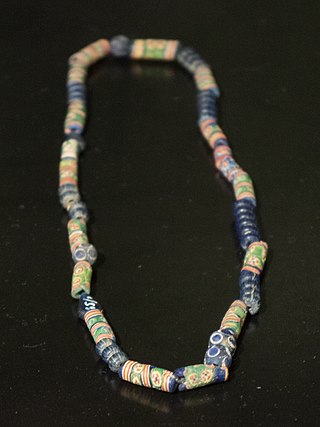
Transport in Albania consists of transport by land, water and air, which are predominantly under the supervision of the Ministry of Infrastructure of Albania. The development and improvement of the transport in the country remains among the most important priorities of the Government of Albania.
A ferry is a watercraft that carries passengers, and sometimes vehicles and cargo, across a body of water. A small passenger ferry with many stops, such as in Venice, Italy, is sometimes called a water taxi or water bus.

A water taxi or a water bus is a watercraft used to provide public or private transport, usually, but not always, in an urban environment. Service may be scheduled with multiple stops, operating in a similar manner to a bus, or on demand to many locations, operating in a similar manner to a taxi. A boat service shuttling between two points would normally be described as a ferry rather than a water bus or taxi.
The majority of public transport users in the Bristol Urban Area are transported by bus, although rail has experienced growth and does play an important part, particularly in peak hours. There were plans for a light rail system, however this has now been dropped although it remains in the long-term local transport plan.

The Fierza Hydroelectric Power Station is a large hydroelectric power station on the Drin River, in Albania.

The Koman Hydroelectric Power Station is a large hydroelectric power station, for which a dam on the Drin River was built. The dam is near the settlement of Koman, northern Albania. It is the second of three dams on the Drin River; the Fierza Hydroelectric Power Station upstream, and the Vau i Dejës Hydroelectric Power Station downstream. The dam, 130m tall, was completed in 1985 and the reservoir was filled with water at full capacity in 1986.

Fierzë is a town and a former municipality in the Kukës County, northern Albania. At the 2015 local government reform it became a subdivision of the municipality Tropojë. Fierzë sits on the right, northern bank of the Drin, opposite the village Fierzë in Fushë-Arrëz municipality.

Vau i Dejës, English: Deja's Ford, is a town and a municipality in Shkodër County, northwestern Albania. It was formed at the 2015 local government reform by the merger of the former municipalities Bushat, Hajmel, Shllak, Temal, Vau i Dejës, and Vig-Mnelë, that became municipal units. The seat of the municipality is the town Vau i Dejës. The total population is 30,438, in a total area of 499.35 km2. The population of the former municipality at the 2011 census was 8,117.

Shurdhah is an island in northern Albania in the Vau i Dejës Reservoir. It was formed after the flooding of the Drin river valley during the construction of the HPS. It is the largest island in the reservoir with an area of 7.5 hectares. From the most northern tip of the island to the most southern tip of it, it has an estimated length of 390 m (1,280 ft).It is accessible by tourist boat in summer from the Vau i Dejës dam or Rragam. Shurdhah attested in medieval sources as Sarda and its submerged area were an early medieval settlement in Albania linked to the Komani-Kruja culture.
Liverpool in North West England, is a major British city with significant road, rail, and ferry networks, in addition to an international airport and a well-known dock system. As with most other major UK cities, Liverpool's transport infrastructure is centred on its road and rail networks. Public transport services within the city are controlled and run by Merseytravel.
Hornblower Cruises is a San Francisco–based charter yacht, dining cruise and ferry service company. In 2021, the company rebranded most of its services as City Cruises or City Experiences. In 2024, the company filed for bankruptcy protection.

The Bajzë Rail Station is a railway station located in Bajzë, Albania. It is operated by Hekurudha Shqiptare (Albanian Railways) and part of Montenegrin-Albanian cross-border freight line between Podgorica, capital of Montengero, and Shkodër, Albania. Two freight trains pass daily through the station, hauling over 10,000 tonnes of commodities monthly. Long term plans exist to establish and operate international passenger trains between Albania and Montenegro via Bajzë. The vast majority of Albanian entrepreneurs import their goods through the railway line from all over Europe, as transport through train is about 50% cheaper than road transport. Cleaning of toxic chemicals, which had been dumped during 1991-1992, finished in 2009.
The 2010 Albanian Floods refer to several periods of major flooding in the northern regions of Albania around Shkodra, Lezhë and Durrës between December 2009 and January 2010.

Koman is a settlement in the former Temal municipality, Shkodër County, northern Albania. At the 2015 local government reform it became part of the municipality Vau i Dejës. The Koman Hydroelectric Power Station has taken the name of the settlement.

Archaeology of Kosovo as a field of study and research was started in the second half of the 20th century. Kosovo's field of archaeology has developed in tandem with the historical study, studies of ancient authors' sources, classic philological studies, theological data research, topographic studies and ground survey, analysis of toponyms, deciphering of epigraphic and historiographic data. First data about antique monuments in Kosovo, were documented from the end of the 19th until the beginning of the Second World War, a time period when Kosovo was visited by researchers, guides, and archaeologists such as: Evans, Boue, Hahn, Kanitz, Tomaschek, Domaschevski, Arpad, Vulic, Jirecek, Patsch, Domenico Mustilli, etc.

The Roman heritage sites in Kosovo represent a multitude of monuments of material and spiritual culture, which reflect the Roman period in this region. Among them, a special place is occupied by those that represent the development of art, such as the plastic monuments that are more frequent, and at the same time occupy an important place, because with the presentation of figures in relief and with numerous inscriptions they speak to us enough for this period.

The Komani-Kruja culture is an archaeological culture attested from late antiquity to the Middle Ages in central and northern Albania, southern Montenegro and similar sites in the western parts of North Macedonia. It consists of settlements usually built below hillforts along the Lezhë (Praevalitana)-Dardania and Via Egnatia road networks which connected the Adriatic coastline with the central Balkan Roman provinces. Its type site is Komani and its fort on the nearby Dalmace hill in the Drin river valley. Kruja and Lezha represent significant sites of the culture. The population of Komani-Kruja represents a local, western Balkan people which was linked to the Roman Justinianic military system of forts. The development of Komani-Kruja is significant for the study of the transition between the classical antiquity population of Albania to the medieval Albanians who were attested in historical records in the 11th century.

Lake Koman is a reservoir on the Drin River in northern Albania. Lake Koman is surrounded by dense forested hills, vertical slopes, deep gorges, and a narrow valley, completely taken up by the river. Besides the Drin, it is fed by the Shala and Valbona Rivers. The lake stretches in an area of 34 km2 (13 sq mi), its width being 400 m (0.25 mi). The narrowest gorge, which is surrounded by vertical canyon walls, is more than 50 m (0.031 mi) wide. The reservoir was constructed between 1979 and 1988 near the village of Koman with a height of 115 m (377 ft).

Albania was one of only two countries in the world whose entire electricity production was dependent on hydroelectric power.





















